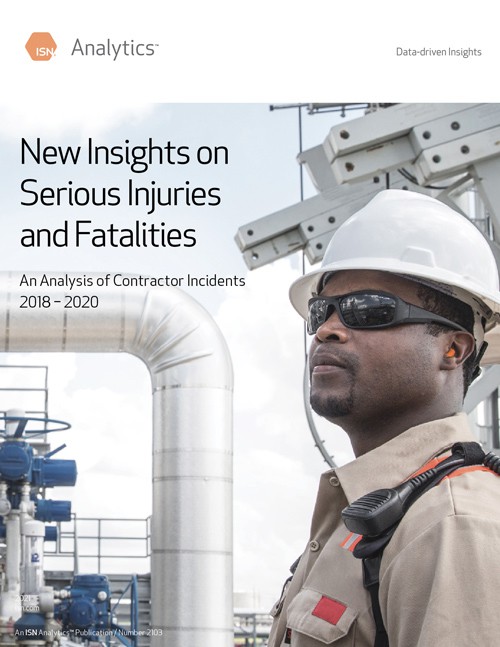The leading cause of serious injuries and fatalities (SIFs) over the last three years was contact with an object or equipment; followed by falls, slips, or trips; then overexertion, according to ISN’s latest Serious Injuries and Fatalities White Paper.
 ISN published the report to further its mission of creating safe worksites. Leveraging its platform data, ISN analyzed more than 60,000 recordable incidents from 2018 to 2020. The findings included in the White Paper will help organizations identify trends in recorded incidents and provide actions they can take to mitigate future SIFs.
ISN published the report to further its mission of creating safe worksites. Leveraging its platform data, ISN analyzed more than 60,000 recordable incidents from 2018 to 2020. The findings included in the White Paper will help organizations identify trends in recorded incidents and provide actions they can take to mitigate future SIFs.
“It’s critical for organizations to understand the context leading to SIFs in order to prevent future incidents and prioritize the health and safety of individuals,” said Brian Callahan, President and Chief Operating Officer at ISN. “By thoroughly analyzing data on SIFs, as well as near misses and potential SIFs, organizations can continue on their journeys to zero incidents and for all workers to return home safe every day.”
Additional highlights from the SIFs White Paper include:
- Seasonal indicators of SIF occurrences: A higher number of SIFs are seen during the summer months, particularly July (average of 587 monthly incidents across the three years analyzed) and August (average of 579 monthly incidents). This may be the result of extended hours of sunlight that permit longer working hours, potentially resulting in fatigue among workers.
- Industry-specific trends: Due to the high-risk nature of the tasks performed, 42% of all SIFs in 2020 occurred among contractors in the Construction industry, followed by contractors in the Administrative Support, Waste Management and Remediation industry (29% of all SIFs).
- Body parts most commonly affected by SIFs: The most common body parts affected year after year were lower extremities, followed by the trunk, and then upper extremities.
- Leading indicators correlated with higher SIF rates: The statistically significant leading indicators that had a strong correlation to higher SIF rates included operating a commercial vehicle, receiving a citation within the last three years, bringing chemicals on site, rigging material handling and working at heights of six feet or higher.
A copy of the SIFs White Paper is available here for download.

















![[VIDEO] Collect Asset Data at the Speed of Walking a Building](https://facilityexecutive.com/wp-content/uploads/2024/02/maxresdefault-324x160.jpg)